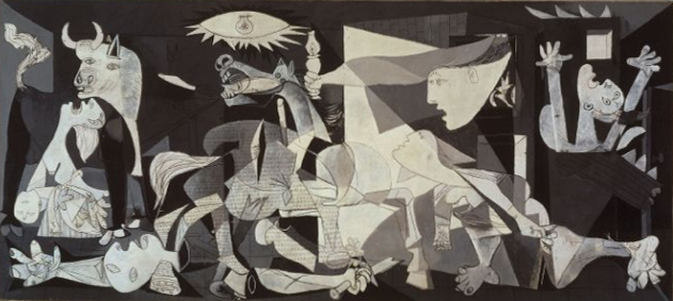|
In 1936 Spanish artist Pablo Picasso was living and working in Paris, France when he was approached by the newly elected Republican government in Spain to create a mural for the next Paris Exposition Universelle, or World's Fair, scheduled for 1937. The timing of the commission coincided with the beginning of the Spanish Civil War in which a failed military coup, by the right leaning Nationalists, against that same government, the left leaning Republicans, devolved in a protracted and bloody conflict. The ensuing violence would come to heavily influence Picasso's handling of his commission- with the final result being a reactionary piece to the news of the bombings of the Spanish village Guernica, after which the painting is titled. The news of Guernica broke on to the international stage in 1937 with reactions of shock and horror. Though it was only one incident in a long list of the campaign of violence by the fascist Nationalists, it marked the first time a sustained and concentrated “saturation bombing” had been targeted on a solely civilian population. Conducted by Nazi bombers on behalf of Generalissimo Francisco Franco, the head of the rebel Nationalist forces, the bombardment lasted over three hours with an estimated 100,000 pounds of explosives being dropped on the village during its busiest hours. Civilians trying to escape were gunned down by additional fighter planes held in reserve for that exact purpose. By the time the fires were extinguished three days later, seventy percent of the buildings were destroyed and about one third of the population of Guernica was dead. Though the bombardment took place on the 27th of April, the news wouldn't reach Paris til May 1st where Picasso would encounter the pictures and story on the front pages of newspapers such as L'Humanité or Paris Soir. Picasso, who had been previously working on a series of etchings and aquatints titled the Dream and Lie of Franco, was immediately spurred into action to both commemorate and decry the violence that had taken place. Completed in under three weeks, Picasso created Guernica as a larger than life mural depicting the horrors of war. Fragmented, layered, broken and abstract, the monochromatic figures of humans and animals stand out starkly against a dark background -no doubt echoing the images Picasso saw spread across the pages of the Parisian newspapers. The scene itself is one of chaos, with burning buildings, fleeing figures, a distorted bull, a mother weeping for her dead child, and the wounded figure of a horse standing over the body of a dead soldier, all those present in the painting express their horror at inhumanity perpetuated by the Nationalist forces. Hung in the Spanish Pavilion at the 1937 Exposition Universalle, Picasso accompanied Guernica with newsreels, documentaries and photographs of the atrocities committed by Franco and his men. Picasso intended his mural to be an active political piece, a commentary not only on the the violence occurring within Spain but also a warning against the evil which could be achieved through modern warfare. It was no coincidence that Picasso chose to document the first civilian bombardment that used improved airplane artillery in a year that the exhibition's theme was modern technology. His work served to both highlight and forewarn against the tactics which would soon envelope Europe during the Second World War. Picasso departed from the image of war as heroic, much like his predecessor Goya did in his works The Disasters of War Series, and instead chose to focus in on the tragedies that befell those the war encompassed. Guernica went on from its Paris exhibition to tour the world at the behest of the Spanish Republican government in order to raise awareness and funds for the conflict, a propaganda piece for their cause. At the outbreak of World War II, Picasso signed the painting over to the Museum of Modern Art in New York with the proviso that it be returned to his home country once Spain gained a democratic government, something which did not occur until 1981. Though the exact symbolism of its figures is still debated, through its various exhibitions and publications Guernica has grown to become the face of antiwar sentiment for the 20th century and is still referenced to this day. Bibliography
1 Comment
|
AuthorCrystal has a MA in the History of Art from Courtauld Institute of Art as well as a BFA in Art History from the Academy of Art University. Archives
November 2017
Categories
All
|



 RSS Feed
RSS Feed